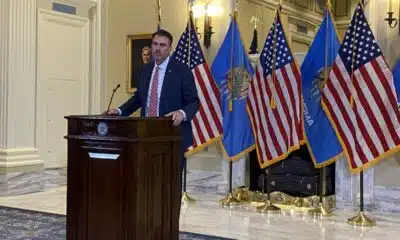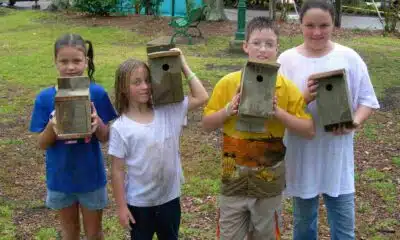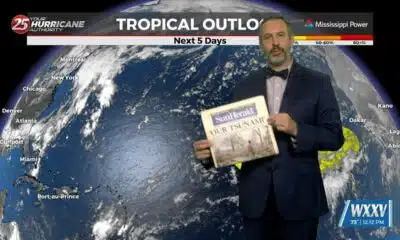News from the South - Oklahoma News Feed
Incarcerated Women Find Their Voices Through Journalism
A number of obstacles needed to be cleared.
Ellen Stackable recalled the moment in April 2024 when she was introduced to the CEO of Prison Journalism Project so she could discuss an ambitious plan to launch inmate-run newspapers at Oklahoma’s two women’s prisons, Mabel Bassett Correctional Center in McLoud and Dr. Eddie Warrior Correctional Center in Taft.
Stackable was the founder of Tulsa’s Poetic Justice, which for more than a decade has been offering writing classes in women’s prisons in Oklahoma and beyond. Until last year, the courses focused on creative forms of writing. The first hurdle to clear was that some of Stackable’s own board members worried that a shift into journalism might represent mission creep.
She won that one: newspapers fit with Poetic Justice’s mission of rewriting narratives to transform the story of incarceration.
Prison Journalism Project, which since 2020 has been working to create a national network of prison journalists, signed on to the effort without hesitation.
The next hurdle was the Oklahoma Department of Corrections.
“Anytime you want to do anything new in a prison, their go-to is always no,” Stackable said. “So you have to figure out how to ask in a way to get a yes.”
For that, she had an ace up her sleeve: Kay Thompson, the DOC Chief of Public Relations, worked as a reporter for the Okemah News-Leader for 10 years, covering the school board, city council meetings and local politics before moving into government positions and eventually corrections.
The top brass of DOC gathered at a gallery show of artwork created through Poetic Justice’s efforts. Stackable seized the moment to approach Thompson about the newspapers; if she was worried, she needn’t have been.
“When they brought this to me, I was super excited,” Thompson said. “I was like, yes, I’ll do whatever I can to make this happen.”
It got easier from there. Twenty women from each prison applied for ten staff positions on what would become the Mabel Basset Balance and the Warrior Standard. Applicants saw a flyer announcing the newspapers, or heard a rumor, or peeked over the shoulder of someone scribbling out a sample essay.
PJP arranged three visits to Oklahoma in the summer of 2024 to offer crash courses in best journalistic practices.
The first issues appeared 13 weeks after the effort was launched. Inaugural editorials acknowledged the challenges faced and established ambitious goals.
“These past few years have been chaotic, and we understand that change is scary,” the Balance editors wrote. “We promise to do our very best to promote and highlight issues you care about.”
The Standard editors spoke even more directly to the question of whether a prison publication could function as a true newspaper, asking tough questions and holding officials to account.
“Our goal is to set a new standard,” the editors wrote. “This doesn’t mean we don’t look for answers to questions that concern us, but it does mean we address our issues responsibly and with integrity, mindful of the fact that we are all, one way or another, in this together.”
As the publications’ third issues make their way into the world, the Balance and the Standard have been named finalists for a coveted Stillwater Award from the Society for Professional Journalists.
Not Only Good for Rehabilitation
The crimes committed by the editors and writers who run the Balance and the Standard are a sobering gut punch that stands in stark contrast to the happy camaraderie of the women as a group, a joyfulness that would surprise and delight any newsroom reporter.
The Balance meets for two hours every other Thursday; the Standard meets every other Friday. On top of researching, writing, and editing stories, staff members work full-time prison jobs.

The benefits of prison journalism stretch well beyond the traditional role of the Fourth Estate.
In a 2023 piece about journalism and recidivism rates for the San Quentin News, Steve Brooks said that journalism provided a sense of purpose for inmates serving life sentences and taught hard and soft skills that would be useful after an inmate was released.
“Journalism is not only good for rehabilitation; it can be a viable career choice after prison,” Brooks wrote.
Shaheen Pasha, writing in 2018 for Nieman Reports from Harvard’s Neiman Foundation, described the bridge that journalism education can build between the incarcerated and the outside world.
“For those incarcerated, the study of journalism can provide tangible skills, such as writing, critical thinking, social skills and a foundation in ethics that are invaluable on the outside, regardless of profession,” Pasha said.
Staff members of the Balance and the Standard went even further.
Reporters at both papers said journalism skills helped them come to a better understanding of other people and of themselves. They had learned the power of leaving things unsaid.
Some writers reflected on how journalism skills might have affected their ability to participate in their own legal defense.
Michelle McCutchan, a Standard co-editor who was released shortly after her last Forgotten History feature was published, recalled her attempts to over-explain her case when she went before a judge.
“I think now I have a tool,” McCutchan said. “If I’m needing to be persuasive in a way, whatever it is in the future, I really know how to focus my thoughts on a singular idea, and not jumping around to everything else.”
Kelsey Dodson, also a Standard reporter, agreed that a journalist’s skills would have been handy when she struggled, at 20, to understand the questions detectives asked her. Regardless, moving forward, the skills would prove invaluable.
“In the future, I’m going to be teaching in the R.I.S.E. program,” Dodson said, referring to an onsite cosmetology school. “Journalism will help me in becoming a teacher of anatomy and chemistry.”
The Censor
Thompson, of the DOC, was in a unique position. On the one hand, she knew that it was a reporter’s job to hold the government accountable.
“Reporters asking questions, digging into things, that’s to be expected,” Thompson said.
On the other hand, she had a peculiar role when it came to the Balance and the Standard: it was her job to put the kibosh on stories that crossed the line.
It happened once. Thompson killed a piece of satire that included details of illegal activities on the yard; she was promptly criticized for it.
Thompson’s objectivity — as either a former journalist or a DOC official — evaporated when it came to the Balance and the Warrior; her support for the newspapers’ efforts was personal and emotional.
And she blurred traditional lines. Like volunteers for Poetic Justice, and Stackable herself, who perform logistical editorial duties or arrange interviews or gather sources for reporters, Thompson had been given a photo credit in a recent issue.
Questions linger about what prison newspapers are permitted to say.
In a 2024 opinion piece for PJP, Kevin Sawyer, reflecting on 27 years as a prison journalist in San Quentin, described the risks of prison journalism and took note of the many ways California had attempted to silence prisoners’ free expression.
Sawyer cited a Supreme Court case, Turner v. Safley, which established that inmate speech could be censored only when there was a valid connection to security or rehabilitation.
“The public’s right to know does not exclude what prisoners have to say or write,” Sawyer said.
The staffs of the Balance and the Standard said that concerns over censorship troubled them right from the start.
Balance Editor Deborah “Jax” Frank said their stories needed to be carefully crafted and solutions-based.
“How we feel about something, we have to work hard to get the emotion out of it,” Frank said. “These are our days, our lives.”
Despite fears, the newspapers’ early issues called attention to the difficulty of obtaining materials to renovate living spaces and took oblique notice of dilapidated buildings by celebrating efforts to refurbish them.
Apprehension for the third issues ran higher.
They were pleasantly surprised. Thompson approved stories that called out the punishing, callous nature of prison; that offered unflinching criticism of Oklahoma’s 85% rule; that documented the persecution of rural communities with outsized criminal fines that amounted to a second round of punishment; and more.
Warrior Editor Geneva Phillips pointed to even loftier ambitions.
“Our goal is not to push the envelope,” Phillips said. “Our goal is to represent the people we are incarcerated with. Our goal is to give honest, thoughtful, conscientious voice to the issues that impact our lives.”
The Eye Opener
In the late 1930s, a newsletter called the Eye Opener was launched at Oklahoma State Penitentiary in McAlester.
The Eye Opener quickly morphed into a full-fledged newspaper.
In 1941, the paper provided coverage of the death of warden Jess Dunn, who was killed in an OSP prison break; an opinion piece memorializing Dunn ran alongside an account of the uprising.

In 1964, the Eye Opener printed an earnest letter to the editor that called for improvements to the paper itself.
In 1972, editor Verdell Sexton penned a plaintive opinion piece about the futility of prison reform.
“Virtually every adult in this nation has read or heard over television and radio, of the failure of the United States prisons to render any sort of rehabilitative effect to the prisoners,” Sexton wrote. “Still, there is nothing being done to change the ‘system’ of corrections!!!”
The Eye Opener ceased publication a short time later, likely due to the infamous 1973 McAlester Prison Riot.
Apart from the Balance and the Standard — and excluding the stray newsletter — Thompson was unaware of efforts to launch a newspaper at any other Oklahoma prison.
“I would love to have a newspaper stand up at every facility, because what brings communities together more than a newspaper?” Thompson said. “To have volunteers stand up at a men’s prison would be great.”
The communities of their yards were front of mind as the staffs of the Balance and the Standard awaited notification of the Stillwater Award; so was the broader society to which some of them would eventually return.
“I think the newspaper has offered us a sense of community that did not exist before,” Standard editor Phillips said. “I think that it is very empowering to have a group of women investing their time and their effort and their hopes in a positive outlet. That goes beyond the yard, to the entire world.”
Balance reporter Michelle Walker expressed the same sentiment, more succinctly.
“We’re not a prison publication; we’re a publication,” Walker said.
The Society for Professional Journalists’ award ceremony will be held May 8.
This article first appeared on Oklahoma Watch and is republished here under a Creative Commons Attribution-NoDerivatives 4.0 International License.
The post Incarcerated Women Find Their Voices Through Journalism appeared first on oklahomawatch.org
Oklahoma Watch, at oklahomawatch.org, is a nonprofit, nonpartisan news organization that covers public-policy issues facing the state.
Note: The following A.I. based commentary is not part of the original article, reproduced above, but is offered in the hopes that it will promote greater media literacy and critical thinking, by making any potential bias more visible to the reader –Staff Editor.
Political Bias Rating: Centrist
The article is focused on a program in which incarcerated women find their voices through journalism, highlighting the rehabilitation potential of the project. It reports the development and impact of a prison-run newspaper initiative at Oklahoma’s women’s prisons, sharing details about the participants, the challenges they faced, and the program’s broader societal benefits. The content presents factual reporting on the logistics of the program, the personal experiences of the women involved, and the significance of the project in promoting journalistic skills. There is no clear ideological stance or overt bias; it emphasizes rehabilitation and empowerment without engaging in political rhetoric or expressing a political viewpoint. While the topic itself is associated with progressive values (rehabilitation and empowerment of marginalized individuals), the article’s tone remains neutral, focusing primarily on the human interest aspect and the educational benefits of journalism within the prison system. This makes the article largely centrist in terms of political bias. The emphasis is on the positive outcomes of the project rather than presenting a critique of the prison system or broader political issues.
News from the South - Oklahoma News Feed
Family sues Roblox, accusing them of failing to protect kids from predators
SUMMARY: An Oklahoma family is suing Roblox, accusing the popular gaming platform of failing to protect children from predators. The suit centers on a 12-year-old girl allegedly groomed and sexually extorted by a man posing as a 15-year-old boy. According to court documents, the predator coerced the girl into sending explicit photos, threatened to kill her family, and manipulated her using Roblox’s digital currency. The family claims Roblox is a “hunting ground for child predators” and profits from these dangers. Roblox states it has safeguards and recently announced plans to better detect risks. The lawsuit does not specify damages sought.
Family sues Roblox, accusing them of failing to protect kids from predators
Stay informed about Oklahoma news and weather! Follow KFOR News 4 on our website and social channels.
https://kfor.com/
https://www.youtube.com/c/kfor4news
https://www.facebook.com/kfor4
https://twitter.com/kfor
https://www.instagram.com/kfortv4/
News from the South - Oklahoma News Feed
Thousands of State Employees Still Working Remotely
More than 8,500 state employees are working remotely at least some of the time, with the arrangement mostly from a lack of space at agencies.
The Office of Management and Enterprise Services compiled the latest numbers after a December executive order issued by Gov. Kevin Stitt mandating a return to the office for state employees.
The Oklahoma Corporation Commission and the Department of Environmental Quality went in opposite directions on remote work in the second quarter report. Just 12% of employees at the Corporation Commission were on remote work in the first quarter. That jumped to 59% in the second quarter. The agency has relocated as its longtime office, the Jim Thorpe Building, undergoes renovations.
Brandy Wreath, director of administration for the Corporation Commission, said the agency has a handful of experienced employees in its public utility division who work out of state and were hired on a telework basis. Some other employees are working remotely because of doctor’s orders limiting their interactions. The agency got rid of space and offices in the Jim Thorpe Building before the renovations started. The building project is expected to be completed in the next six months.
“At Jim Thorpe, we were right-sized for everyone to be in the office,” Wreath said. “Whenever we moved to Will Rogers, we are in temporary space, and we don’t have enough space for everyone to be in every day.”
Wreath said the Corporation Commission uses the state’s Workday system that has codes for employees to use when they are logged in and working remotely. Employees also know they are subject to random activity audits.
“We’re supportive of the idea of having employees in the workplace and willing to serve,” Wreath said. “We also realize the value of having employees in rural Oklahoma and still being a part of the state structure. Our goal is to make sure our employees are productive, no matter where they are working. We are supportive of return-to-office, and we are utilizing the tools OMES has given us to ensure the state is getting its money’s worth.”
The Department of Environmental Quality now has just 1% of its employees working remotely. That’s down from 30% in the first quarter. Spokeswoman Erin Hatfield said the agency, with 527 employees, is in full compliance with the executive order. Seven employees are on telework, with all but one on temporary telework status as they recover from medical issues.
There are three exceptions to the return-to-office policy: employees whose hours are outside normal business hours; employees who already work in the field; and when new or additional office space would have to be acquired at additional cost.
The Department of Human Services continued to have more than 80% of its 6,060 employees on some type of telework, according to the second quarter report. The agency said those numbers stemmed mostly from a lack of available office space. DHS closed dozens of county offices or found other agency office space for its employees to use in the first years of the COVID-19 pandemic, when there was a huge shift to remote work.
The latest telework report covers 29,250 of the state’s 31,797 employees. About 30% of employees were on some version of telework in the second quarter. Dozens of agencies did not submit quarterly reports to the Office of Management and Enterprise Services.

Paul Monies has been a reporter with Oklahoma Watch since 2017 and covers state agencies and public health. Contact him at (571) 319-3289 or pmonies@oklahomawatch.org. Follow him on Twitter @pmonies.
Related
The post Thousands of State Employees Still Working Remotely appeared first on oklahomawatch.org
Oklahoma Watch, at oklahomawatch.org, is a nonprofit, nonpartisan news organization that covers public-policy issues facing the state.
Note: The following A.I. based commentary is not part of the original article, reproduced above, but is offered in the hopes that it will promote greater media literacy and critical thinking, by making any potential bias more visible to the reader –Staff Editor.
Political Bias Rating: Centrist
This content provides a fact-based report on the remote work status of Oklahoma state employees following an executive order from Governor Kevin Stitt. It presents information from multiple state agencies with no apparent favor or criticism of the executive order or political figures involved. The tone is neutral and focuses on the practical reasons and outcomes of remote work policies, reflecting a balanced approach without clear ideological leanings.
News from the South - Oklahoma News Feed
Test taker finds it's impossible to fail 'woke' teacher assessment
SUMMARY: Oklahoma’s “America First” teacher qualification test aims to weed out “woke” educators from states like California and New York, focusing on civics, parental rights, and biology. However, many find it nearly impossible to fail. Test-takers, including independent publisher Ashley, report multiple attempts allowed per question, enabling passing regardless of knowing answers, often by guessing until correct. Average Oklahomans tested struggled with the questions, highlighting the test’s difficulty and questionable effectiveness. Critics say the test’s ease defeats its purpose of ensuring teacher knowledge. The state superintendent’s office was contacted for comment but had yet to respond.
Test taker finds it’s impossible to fail ‘woke’ teacher assessment
Stay informed about Oklahoma news and weather! Follow KFOR News 4 on our website and social channels.
https://kfor.com/
https://www.youtube.com/c/kfor4news
https://www.facebook.com/kfor4
https://twitter.com/kfor
https://www.instagram.com/kfortv4/
-
Mississippi Today3 days ago
DEI, campus culture wars spark early battle between likely GOP rivals for governor in Mississippi
-
News from the South - North Carolina News Feed6 days ago
Parasocial party: Why people are excited for the Taylor Swift, Travis Kelce engagement
-
News from the South - Louisiana News Feed6 days ago
K+20: Katrina alters local health care landscape, though underlying ills still the same
-
Our Mississippi Home7 days ago
The Great Backyard Recovery – Helping Birds After the Storm
-
Local News6 days ago
Police say Minneapolis church shooter was filled with hatred and admired mass killers
-
Local News Video5 days ago
08/29 Ryan's “Wet End to the Week” Friday Forecast
-
Mississippi News Video7 days ago
MAGNET seeks to drive industry to the South | Alabama
-
News from the South - Arkansas News Feed7 days ago
Catholic community in Fayetteville prays for Minneapolis victims, reflects on safety










































